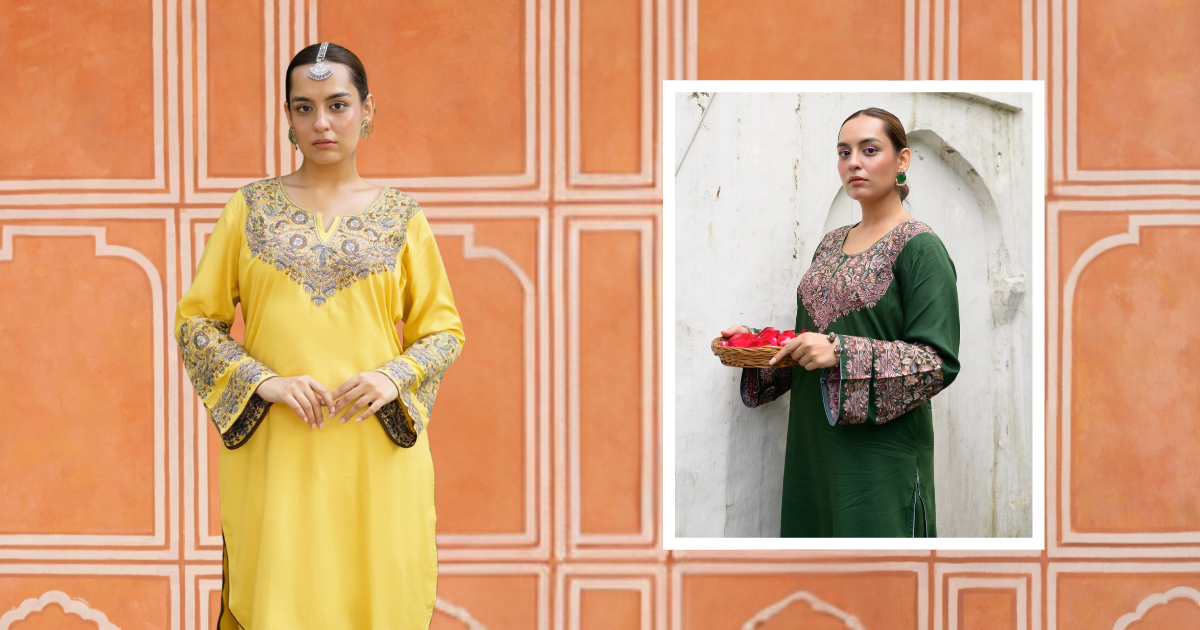In the busy streets of Aminabad and the quiet spots of Hazratganj, Lucknow tells a story. This city, known as the 'City of Nawabs', has a special art called Chikankari. It's a type of stitching that many people in India love. Chikankari is not just a design; it shows how talented and hardworking the people of Lucknow are.
Chikankari and Lucknow: An Inextricable Bond
The connection between Lucknow and Chikankari is as old as the history of the city itself. The origin of Chikankari in Lucknow are a bit hazy, with some narratives attributing it to the influence of the Mughals, especially Empress Noor Jahan. She, smitten by the art form, promoted it extensively, turning it into a preferred craft of the royal court. This royal patronage not only gave Chikankari the necessary impetus to grow but also rooted it firmly in Lucknow's socio-cultural fabric.

The difference between Chikankari and Lucknowi
In the realm of textiles, terms often become intertwined with regions, leading to a blend of names that can sometimes cause confusion. Such is the case with "Chikankari" and "Lucknowi Chikankari." At their core, they refer to the same exquisite art form. The prefix "Lucknowi" is a nod to the city of its prime resurgence and dominance - Lucknow.
It emphasizes the geographical origin and the rich tradition of the craft from this particular city. In essence, when someone speaks of "Lucknowi Chikankari," they are underscoring the authenticity and tradition of Chikankari as it is practiced in the heart of Lucknow. To put it simply, there is no difference in the craft itself; it's akin to cherishing a delicacy and then linking it to its place of origin for added reverence.
The Dawn of Chikankari in Lucknow
During the Mughal era, Lucknow was a melting pot of artisans, poets, and craftsmen. Amid this cultural renaissance, Chikankari found its ground. Initially, the craft was confined to white yarn on muslin cloth, reminiscent of the Persian 'Chikan' work, from which it draws its name. As the craft grew, local artisans began experimenting, integrating their creativity, resulting in diverse designs and motifs, primarily influenced by Mughal architecture and flora.
The Markets Then and Evolution
The bylanes of old Lucknow, particularly the Chowk area, became the epicenter for Chikankari. Artisans would sit in small karkhanas (workshops), meticulously weaving tales on fabrics. The Chikankari markets of Lucknow were bustling with buyers, ranging from royalty and nobility to commoners, all drawn by the allure of this intricate craft. However, post-Mughal era and during British rule, Chikankari experienced a decline. The royal patronage dwindled, and the craft, devoid of its primary clientele, faced challenging times.
The Resurgence and Modern Markets
The late 20th and 21st centuries saw a resurgence of Chikankari, thanks to the efforts of designers, local artisans, and NGOs. They revived ancient techniques, introduced contemporary designs, and expanded their reach beyond traditional wear. Today, the markets of Lucknow are vibrant again with Chikankari. From dedicated Chikan shops in Aminabad and Hazratganj to luxury boutiques and even online platforms, Chikankari has found a global audience. Modern iterations like Chikankari on denim, fusion dresses, and home decor items have made this ancient craft relevant to today's clientele.

Conclusion
Lakhnavi Chikankari, with its delicate stitches and timeless appeal, is a living testament to Lucknow's artistry and resilience. From royal courts to global fashion ramps, this craft has traversed a journey of ups and downs but has remained, at its core, quintessentially Lucknawi. Today, as you walk through the streets of Lucknow, amidst the aroma of kebabs and sounds of ghazals, the sight of a Chikankari artisan, lost in his craft, is a poignant reminder of a city that clings to its roots while embracing the winds of change.
Step into the world of authentic Lucknowi Chikankari with Namastay's exclusive collection. From the ever-classic white cotton Chikankari kurta to the bold allure of the black Chikankari kurta for women and more, our range celebrates the intricate artistry that defines this timeless craft. Whether you're looking for a traditional piece or seeking to elevate your everyday style with Chikankari tops for jeans, we've got you covered. And, for those who embrace every curve, our plus-size Chikankari kurta ensures elegance for all. Dive deep into a legacy with every thread and motif, and let the spirit of Lucknow radiate in your style. Discover a confluence of tradition and trend with Namastay.

















